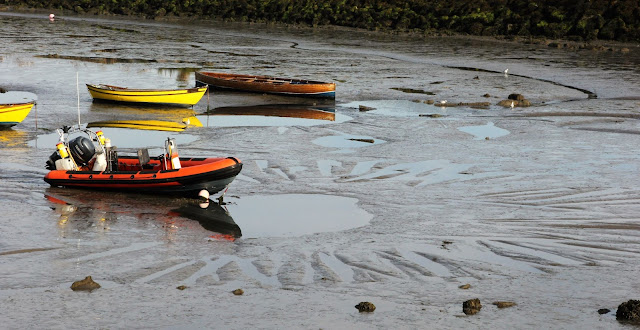 |
| Howth Marina at Low Water |
The passage south from Islay went perfectly, though the 3.30am alarm clock call wasn't greeted with huge enthusiasm. Once we set sail, though, we had excellent beam-reaching sailing and our Orkney Tides Masterclass seems to have paid off; we picked up the fast-flowing, south-going tide off Rathlin Island and carried it all the way south.
The wind began to falter as we came in to the lee of the land but we decided to continue on to Bangor, completing the 63nm passage in just over 9 hours.
After an overnight stop in Bangor, it was another relatively early start for the 89nm passage down to Howth, just north of Dublin. Again we had good tidal assistance but slightly fickle winds so there was a mix of sailing and motor-sailing, with about 15 dolphins coming to join us for 20 minutes on route.
Our 7.00pm arrival in Howth was about 90 minutes before Low Water and we called the Howth Yacht Club on the VHF for advice on water depths. The very helpful chap who responded explained that the harbour has silted up and it'd be marginal as to whether we'd get in. He advised that we should either wait at anchor for about 3 hours (for the rising tide) or else 'have a good run at it!'. The silty mud is very soft so we reckoned that the worst that could happen would be us sliding to an ignominious halt in full view of all the locals watching from the Yacht Club terrace.
We're glad to report that we made it to our marina berth, though for the last 100m the depth-sounder showed only 1.5m of water and Maunie draws 1.8m! We ploughed a neat furrow through the silt thanks to our momentum and a healthy dose of engine power. At full low-tide we could see just how silted the harbour has become:
 |
| The entrance to Howth Harbour. The old lighthouse is no longer functional but is still inhabited |
 |
| The final approach to Howth marina. The Yacht Club is the blue and white roofed building |
 |
| The marina at Low Water - most of the boats have their keels stuck in the soft mud |
Howth is a busy fishing port but also a seaside town for Dubliners, connected to the city by a frequent 30-minute DART train service. The Yacht Club is the largest in Ireland and has a competitive racing fleet. There's a fleet of one-design wooden boats called Howth 17's which race twice a week; most of them are about 110 years old.
We've been here for a few days while the winds have blown steadily from the south and the temperatures have risen. Our trip into Dublin yesterday coincided with the hottest day recorded in 135 years - 33.1 degrees in the city - but nevertheless we enjoyed seeing the place. It was, however, crowded with foreign tourists (that category includes us, we suppose), it seemed strewn with litter and, after several days of no rain, a city with thousands of bars and not enough public toilets smelt chiefly of impatience.
Talking of which, we're impatient to get moving again. The heatwave will end today with the welcome (for us) switch to northerly winds so we'll head off tomorrow morning for the little harbour in Arklow, about 40nm further south. After that we'll probably head on to Kilmore Quay, at the very SE corner of Ireland to plan the 130nm crossing to the Isles of Scilly.




No comments:
Post a Comment